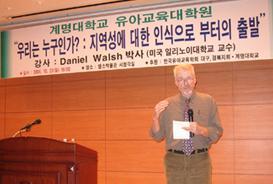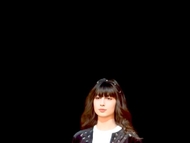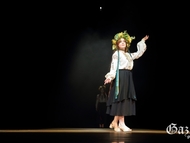 Editorial note: This lecture, organized and sponsored by the Keimyung Graduate School of Early Childhood Education and the Daegu & Gyeongbuk Division of Korean Society for Early Childhood Education, was given by Dr. Daniel J. Walsh (Curriculum & Instruction, University of Illinois at Urbana-Champaign) on Oct. 23 at Hengso Museum. The Gazette carries the lecture in three parts.
Editorial note: This lecture, organized and sponsored by the Keimyung Graduate School of Early Childhood Education and the Daegu & Gyeongbuk Division of Korean Society for Early Childhood Education, was given by Dr. Daniel J. Walsh (Curriculum & Instruction, University of Illinois at Urbana-Champaign) on Oct. 23 at Hengso Museum. The Gazette carries the lecture in three parts.Both teaching and research are done in culture. We are immersed in culture. We are, before all else, cultural beings.
Culture itself is both local and general. Culture is local in that it varies from group to group. Culture is general in that it is shared by everyone in a given group. The fact that culture is shared, a shared set of beliefs about what people should or should not do, what people are like, what goes with what, when and how we should do what we should do, with whom and so, does not make all of us in a given group exactly alike. Culture constrains, that is, it limits the probable and the possible, but it does not determine or dictate. Any healthy culture accepts a wide range of the normal or acceptable.
For example, Korean culture is general within boundaries, but local to those boundaries. Whatever comprises Korean culture, it has borders. At some point, if I start traveling—the example would be more apt if Korea were not bounded by water on three sides and a DMZ on the fourth—but as I travel, I will leave this culture and enter another. The borders may be porous, and at the borders, much may be shared. The Korean influence in western Japan is obvious even to an outsider’s eyes like mine, for example, in the architecture. My point is simple. Korean early schooling occurs within the constraints of Korean culture. And teaching in Korean early schooling and doing research on Korean early schooling are constrained by Korean culture.
The Soviet psychologist Vygotsky was most critical of what he called the search for the “eternal child,” for the “universal child.” The goal in early childhood education of both research and teaching should be the historical, cultural, and situational child, that is, the local child, now (in 2006), here (in Korea), and in this specific situation (early schooling).
One may ask, “But aren’t students much the same? Don’t we know what 5-year-olds or 20 year-olds are like?” We know something, but there is much we do not know. And what we do know is always changing.
I am continually amazed by how much undergrads have changed across the years. Twenty years ago few of the undergrads I taught had attended preschool or daycare, less than a quarter of the class. Now when I ask, all have. Many started as young as two-years-old, or younger. Twenty years ago, juniors in college were entering, counting kindergarten, the 16th grade. Now they are entering the 18th or 19th or even 20th grade. They’ve been in school, in institutions of some kind, for many years. They are different from their predecessors. For one thing, when we discuss working with preschoolers, they bring their own experience as preschoolers into the conversation.
People differ, and people change. They differ across cultures, not simply on the surface, in language and dress and rituals, but down deeply, in their beliefs and values and expectations. People differ and change within cultures, across subgroups, and across time. Again, not simply on the surface, but down deeply. The fact is, no matter how well you and I can communicate, as products of distant cultures, we think most differently about many things in life. These profound differences limit our ability to generalize. Research and teaching were easier before we started to take culture seriously. One simply assumed that what one found was true of people in general. It is not. It never has been.
An Imported Idea
I am told that some of you are interested in schooling for children who are labeled gifted. I must warn you at the beginning that I am critical of the history of what is known as gifted education and of the conceptions of intelligence on which it has been based. And I also must confess that I know nothing about gifted education in Korea.
Intelligence is a core, deeply embedded, and tightly embraced concept in American culture. It was attractive in the U.S. for many reasons. One reason is that it was universal. Alfred Binet never intended his test to measure intelligence. He developed a test for young children in the early 1900’s, in response to a request from the French Ministry of Education to help schools identify children who would have difficulty in school and need extra help. In the hands of American Lewis Terman Binet’s test, developed for particular local need, became the Stanford-Binet, an intelligence test that supposedly established a person’s IQ, his intelligence. Intelligence was defined as basically immutable, something one is born with. When Binet found out sometime later how his test was being used in the US, he was outraged and condemned this use.
Ideas about intelligence have changed, and as they have, they have become more particular. In the U.S., Howard Gardner developed the idea of multiple intelligences. Certainly it has become difficult to maintain the idea that intelligence, whatever it is, is immutable. Margaret Donaldson (1978) wrote (my comments in square brackets):
While it may make some sense to postulate [note: it may make some sense to postulate] that we each possess some genetically determined “intellectual potential,” in which case individuals will surely differ in this respect as in others [e.g., hair color, height, hand size etc], there is no reason to suppose that most of us—or any of us, for that matter—manage to come close to realizing what we are capable of. And it is not even certain that it makes a great deal of sense to think in terms of upper limits at all. For, as Jerome Bruner points out, there are tools of the mind as well as tools of the hand—and in either case the development of a powerful new tool brings with it the possibility of leaving old limitations behind. In a similar vein, David Olson says: “Intelligence is not something we have that is immutable; it is something we cultivate by operating with a technology, or something that we create by inventing new technology.” (p. 86)
My view is that sometimes schooling “gifts” children, that is, it helps them acquire tools of the mind, and sometime it robs them, that is, it hinders them from acquiring those tools. Some forms of schooling are better at doing this than others. Some children may appear initially more receptive to the gift than others. The goal should be to make early schooling a gift for all.
I believe that the challenge for Korean educators is to take this, and other, very American concepts, that are intricately connected with many underlying Western cultural ideas about learning and development and explore them most critically. Unless this idea is made local, unless it is made sense of in terms of Korean culture and beliefs, it will remain a foreign and ultimately intrusive idea.(To be continued)
References
Donaldson, M. (1978). Children’s minds. New York: W.. Norton.








